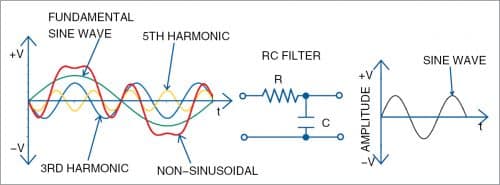The sine wave is a smooth waveform that oscillates (moves above and below zero periodically) as shown on the RHS of Fig. 1. This kind of wave pattern often occurs in nature including wind, sound, and light. An alternating current or voltage changing in this manner can also be represented by a sine wave. It shows how the amplitude of a variable changes with time. AC power is represented graphically by a sine waveform.
A pure natural sine wave signal without distortions or harmonics consists of only the fundamental frequency. However, practically there could be distortions in the power supply lines. For example, in a pure sine wave inverter, harmonics could be introduced back into the sine wave by loads such as fluorescent light ballasts, computers, and motor controllers that draw current in pulses.
AC signal waveforms consist of frequencies called harmonics that are multiples of the fundamental frequency. If a waveform has a fundamental frequency of 5kHz, the multiples 10kHz, 15kHz, 20kHz, and so on—the harmonics—could also be present in the waveform. Harmonics cause overheating problems on power lines, connecting wires, motors, transformers, and trip the load intermittently and reduce the power factor.
Harmonics are eliminated using filter networks which may comprise resistors, capacitors, and inductors. The filter blocks certain frequencies but allows required sine wave to pass on to the load. Fig. 1 illustrates filtering of harmonics to get pure sine wave using a resistor-capacitor (RC) filter circuit.

Inverter circuits can generate different sine wave outputs. There are three major types of inverters: pure sine wave, modified sine wave, and square wave inverters.
Pure Sine Wave
A pure sine wave energy is produced by your local utility company or power plant and by some pure sine wave generators/inverters. These inverters are the most expensive ones and outperform all other types of inverters. Main advantage of a pure sine wave inverter is that most of the equipment/electrical appliances will work off them without any problem. That is, pure sine inverters can be used to run complex devices, circuit boards, medical equipment, microwaves, and more.
Modified sine wave
It is also called quasi-sine wave. It actually has a waveform more like a square wave, but with an extra step. It is much noisier and rougher than a pure sine wave.
A modified sine wave inverter will work fine with most equipment, although the efficiency or power of the equipment will be reduced. As such some clocks and timers may run faster than the normal or not work at all.
Square wave
The cheapest of all the inverters are square wave. A square wave inverter will work on many electrical equipment but is less reliable and also unsafe for some appliances, and especially so for electronic or computing devices.






